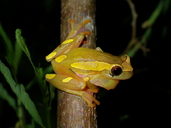|
Dendropsophus arndti Caminer, Milá, Jansen, Fouquet, Venegas, Chávez, Lougheed & Ron, 2017
Arndt's Tree Frog, ranita de Arndt | family: Hylidae subfamily: Hylinae genus: Dendropsophus |
| Species Description: Caminer MA, Mila B, Jansen M, Fouquet A, Venegas PJ, Chavez G, Lougheed SC, Ron SR . 2017 . Systematics of the Dendropsophus leucophyllatus species complex (Anura: Hylidae): cryuptic diversity and the description of two new species. PLoS One 12(3): e0171785. doi:10.1371/journal.pone.071785 | |
|
Etymology: The species epithet, “arndti”, is in honor of Professor Emeritus Dr. Rudolf G. Arndt of Stockton University for his financial support of M. Jansen’s scientific research and for his work in nature conservation (Caminer et al. 2017). |
|
 © 2022 Arturo Muñoz (1 of 2) |
|
|
|
Description Dendropsophus arndti can be differentiated from most other species in the genus by its larger size and wide, dorsolateral bands. From the two most similar species to it, D. leucophyllatus and D. triangulum, it can be differentiated by its rounded sacral mark with small dark spots and irregular edges. It also differs from these two species in its advertisement call; specifically by having a lower duration and number of pulses than D. leucophyllatus and a lower frequency bandwidth and dominant frequency than D. triangulum (Caminer et al. 2017). Dendropsophus arndti can also be differentiated from D. reticulum by its advertisement call and larger size. Dendropsophus reticulum also has a more uniform dorsal color and a red ventral color, which further distinguishes it from D. arndti (Caminer et al. 2017). In life, the background dorsal color is a brown or dark brown with white or bright yellow irregular dorsolateral bands extending to the head and a white or bright yellow circular sacral mark. There are one to two light irregular rounded spots on the dorsal surfaces of the forearms and one to three on the shanks. Some individuals also have a reticulated color pattern. The ventral side and the webbing vary in color from orange to orange-yellow to pink. The irises vary from a dull brown to a coppery bronze (Caminer et al. 2017). In preservative, the dorsum is brown with white dorsolateral bands and a white sacral mark, both with irregular brown spots surrounding them. All of the spots on the limbs as well as the ventral side and the webbing are a dull, creamy white (Caminer et al. 2017). There is some variation in coloration, and some size differences based on sex. The coloration of the ventral side and the webbing vary from orange to orange-yellow to pink, and the irises vary from a dull bronze to a coppery bronze. The number of white spots on the limbs also varies from one to three (Caminer et al. 2017). There is sexual dimorphism, with the females being slightly larger (Caminer et al. 2017). Distribution and Habitat Country distribution from AmphibiaWeb's database: Bolivia
Life History, Abundance, Activity, and Special Behaviors The advertisement call is one pulsed, trill note that lasts approximately 0.19 seconds. Each note has 15 - 19 pulses with a mean dominant frequency of 2655.4 Hz. The mean rise time is 0.12 s and it has a frequency bandwidth of 487.67 Hz. The aggressive call is 3 - 4 pulsed notes with a short average duration of 0.14 s and has fewer pulses than the advertisement call. This call has a mean dominant frequency of 2668.76 Hz, mean rise time of 0.07 s, and a mean frequency bandwidth of 423.26 Hz (Caminer et al. 2017). Larva In life, at Gosner stage 36, the larva is a light to reddish brown with dark brown speckles and large spots both dorsally and laterally. There is a broad, dark brown lateral stripe running from the snout through the eyes to the border between the body and the tail. It has a darker lower edge and a thinner, unpigmented line beneath it. The ventral coloration is a light silver with dark speckles. The tail and fins have the same coloration as the body, and the flagellum is a light brown to yellowish color with large, brown, and sub-rectangular spots with the margins transparent (Schulze et al. 2015). Trends and Threats This species has a very large range with a low proportion of it as degraded habitat, indicating that overall, there are not many threats to this species (Caminer et al. 2017). Comments Maximum Likelihood and Bayesian analyses on nucDNA and 16S mtDNA found that D. arndtiis sister to D. leucophyllatus, with the next most closely related species being D. reticulatus (Caminer et al. 2017). References Caminer, M. A., Milá, B., Jansen, M., Fouquet, A., Venegas, P. J., Chávez, G., Lougheed, S. C. and Ron, S. R. (2017). Systematics of the Dendropsophus leucophyllatus species complex (Anura: Hylidae): Cryptic diversity and the description of two new species. PLoS (Public Library of Science) One 12(3), e0171785 [link] Gosner, K. L. (1960). A simplified table for staging anuran embryos and larvae with notes on identification. Herpetologists' League 16(3), 183 - 190. [link] Schulze, A., Jansen, M., and Köhler, G. (2015). Tadpole diversity of Bolivia's lowland anuran communities: molecular identification, morphological characterisation, and ecological assignment. Zootaxa 4016(1), 001 - 111. [link] Originally submitted by: Nessa Kmetec (2023-10-19) Description by: Nessa Kmetec (updated 2023-10-19)
Distribution by: Nessa Kmetec (updated 2023-10-19)
Life history by: Nessa Kmetec (updated 2023-10-19)
Larva by: Nessa Kmetec (updated 2023-10-19)
Trends and threats by: Nessa Kmetec (updated 2023-10-19)
Comments by: Nessa Kmetec (updated 2023-10-19)
Edited by: Ann T. Chang (2024-08-22) Species Account Citation: AmphibiaWeb 2024 Dendropsophus arndti: Arndt's Tree Frog <https://amphibiaweb.org/species/8602> University of California, Berkeley, CA, USA. Accessed May 15, 2025.
Feedback or comments about this page.
Citation: AmphibiaWeb. 2025. <https://amphibiaweb.org> University of California, Berkeley, CA, USA. Accessed 15 May 2025. AmphibiaWeb's policy on data use. |


 Map of Life
Map of Life